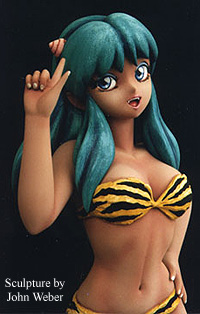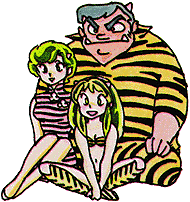
Urusei Yatsura involves a lot of jokes, plots and characters based upon things which are commonly understood in Japanese society. While very humorous to the average Japanese, this causes confusion to UY fans in other countries who aren't quite so familiar with Japanese culture. This page will explain many of the more prominent cultural references that occur in Urusei Yatsura and hopefully lead to a better understanding of the series.
Oni
Mythological Japanese Demons and Space Faring Aliens
 Oni are a mythological race Japanese creatures surrounded by much superstition that still continues today to a small
extent. Once considered gods in ancient times, but ever since the introduction
of Buddhism during the 6th century they began to take on characteristics of demons.
When Takahashi created Urusei Yatsura, she took and your typical aliens of science fiction
fame and combined them with the traditional Japanese Oni. Since much of the premise of UY
comes from these Japanese legends, we must learn about these legends so that one may appreciate much of the humor and irony in Urusei Yatsura. The
article below talks about the original ogre-ish demons. By reading you'll surely
draw many paralels between the Japanese Oni and the alien Oni
Oni are a mythological race Japanese creatures surrounded by much superstition that still continues today to a small
extent. Once considered gods in ancient times, but ever since the introduction
of Buddhism during the 6th century they began to take on characteristics of demons.
When Takahashi created Urusei Yatsura, she took and your typical aliens of science fiction
fame and combined them with the traditional Japanese Oni. Since much of the premise of UY
comes from these Japanese legends, we must learn about these legends so that one may appreciate much of the humor and irony in Urusei Yatsura. The
article below talks about the original ogre-ish demons. By reading you'll surely
draw many paralels between the Japanese Oni and the alien Oni
Karma Chameleon
by Takayuki Karahashi
In popular Japanese mythology and folktales, the oni is a monster of extreme ugliness and strength, thought to threaten the very fabric of human life. The popular visual description of the oni is a hideous, hairy giant clad in only a tiger-skin. His mouth opens all the way to his ears, and facial features include bull horns and tiger fangs. The female oni appear as beautiful women but quickly turn ferocious with jelous rage. Scholars still debate the exact origin of the oni, but it's agreed that this modern image is a latter-day establishment.
Older texts suggest that the ghosts of the dead and anything supernatural (I.e., those things which were'nt considered devine) were called oni (before Japan was unified under imperial rule, members of clans opposing the imperial house were often demonized as oni). As Japan converted to Buddhism, Buddhist images of the rasetsu became confused with the native Japanese oni. The rasetsu is a carnivorous demon-the male utterly ugly, and the female superhumanly beautiful, sometimes depicted as a denizen of hell and thus a lower life form on the great wheel of karma. Later Buddhist lore converts the rasetsu to Buddhism where it becomes a fierce defender of Buddhist beliefs. Chinese astrology, which assigned the twelve Chinese zodiacs to the points of the compass, was yet another spiritual influence on the oni's development. The direction of bull-tiger (northeast) was considered to be the direction of the demon. Thus the oni came to have bull horns, tiger fangs, and tiger-skin underwear. is established in various heroic legends. Regional clans that defied imperial rule were demonized as were bandits and highway robbers who haunted the mountains like invisible spirits. Hence, one of the first shoguns of Japan, Sakanoue no Tamuramaro, historically known for commanding expeditions to quell regional rebellions, is fabled to have slain a famed female oni. The same goes for the bandits turned into the oni of Rashomon, slain by Watanabe Tsuna, and the most famous oni in history, Shuten Doji. Even the oni in the children's story Momotaro or "Peach Boy" are identified as refugee invaders from the Korean peninsula, slain by the historically real Kibitsu no Miko.
Throwing peas at an oni is believed to make him blind. So in the exorcism ritual of Setsubun, held every 4th of February, families throw peas in and out of the house to chase out the evildoing oni for one year. However there are also localities where the oni is treated like a benign spirit such as Saeba of Fukui Prefecture, where the oni performs exorcisms. The "Namahage" oni of Akita Prefecture visits houses on New Year's Eve looking for naughty children to take away with a giant knife. He will leave presents for the good children, but to the adults he is the apparition that visits to bless the household for good harvest the next year.
The oni is a malvolent figure. People who died of famine and epidemics became oni. Wronged women became oni from their jealousy and rage. With the advent of the Noh theater-influenced by Zen Buddhism in medival times-as well as kabuki, which was influenced in turn by Noh, a picture of the oni that has finally settled into the popular consciousness is that of a by-product of human karma.
- end Some facts about the Urusei Yatsura
version of Oni.
Some facts about the Urusei Yatsura
version of Oni.
All Oni have one or more special powers. Rei can turn into a bull-tiger monster, Ten can breathe fire, Everyone in Lum's family can fly, and so on.
All Oni have the following features which destinguish them from humans; They have fangs, horns, pointy ears, wear tiger-striped outfits and they have fiery tempers.
The source of an oni's strength is his horns. Cut them off and they become practically powerless. This has happened a few times when Lum or Ten have lost their horns and suddenly couldn't use their powers.
Oni have a warlike society. They live a relatively peaceful home life, but have been bred to be ready for battle. They gain most of their ground through invasion and fighting.
While Oni are the leaders of their planet, their society is a tossed salad of many different cultures. There are thousands of other species of sentients other than Oni that live on their home planet. The most prominent races are humanoid, but the rest of them are just weird looking buggers.
I'm sure this doesn't apply to Japanese Oni, but the alien Oni have a certain weakness for umeboshi (pickled Japanese plums). In Japan, not only are these used in many Japanese dishes, but they are also used in a way to sober up after drinking too much alcohol. Ironically, they have the very opposite effect on Oni. Instead it causes them to become completely drunk and out of control. Likewise alcohol has the opposite effect.
Even though nasty garlic breath will drive off most humans, Oni have an special weakness to it. It can effectively keep away most Oni as a powerful ward, and too much exposure to the gas emmitted by garlic will cause an oni to develop a condition that causes tears to flow uncontrollably.
Ignoring the umeboshi and garlic weakness, Oni are able to sustain much more than humans.
- Oni can stand greater temperature extremes than humans.
- They have much greater metabolism than humans. Oni food never goes over well with humans, often with disfiguring effects. Ataru has learned this the hard way on many occasions.
- The Oni palette is dulled to the pain of spicy food. Consequently, this also means that their food is a hundred times hotter than earth cooking.
- Oni have a slightly higher threshold for pain.
- They are much less susceptable to earth diseases, but diseases from their planet are very dangerous to humans.
Soon I will add more cultural notes, but for now this is all I've written. If anyone has a certain cultural reference which doesn't make sense to them in mind, give me your suggestion and I can probably answer it. The following is a list of subjects I eventually plan to cover.
- Gaki - a spirit upon which the character of Ran is based
- Japanese fairy tales such as Momotarou, Urashima Tarou and The Grateful Crane
- Tengu (specifically the Crow variety) - Another mythical creature which Kurama and her people are based upon
- The 7 Lucky Gods
- Snow Queen legend
- Overview of Japanese theater (with Ryouko in mind)
- Festivals and holidays native to Japan
- Famous Japanese movies satirized in UY
- Religious practices (with Sakura & Cherry in mind)
- Japanese food
- and more...
